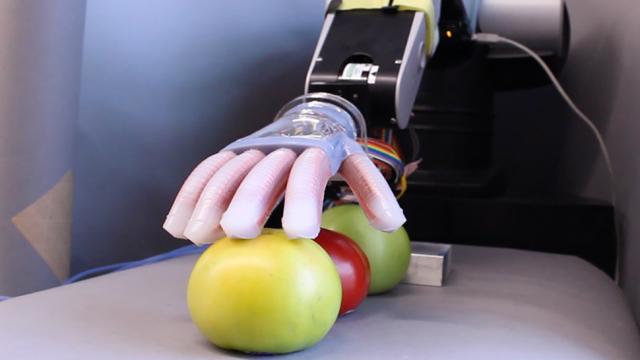Remarkable advancements in artificial intelligence have made it seem like uncannily human androids are just around the corner. But even though SIRI might be able to tell you a joke, robotics are still pretty clunky. That’s where soft robotics come in.
Researchers at Cornell University published a paper this week that details progress in making a mechanical hand that is much closer to mimicking human’s sense of touch. The hand which has been dubbed, “Gentle Bot” is even capable of determining which of three tomatoes is the ripest.
The emergence of soft lithography and 3D-printing over the last 20 years has allowed robotics experts to more easily fabricate and develop sensors that can be incorporated into soft robotics. Optical waveguides are used to sense changes in light, eliminating the need for heavy materials that conduct electricity to be used in the construction of the hand. Now, only materials that can conduct light are necessary.
The Gentle Bot uses a kind of human hand-shaped balloon that has waveguides built in. Seeker explains the sensory process:
Stretchy optical waveguides containing LEDs are built right into the pneumatic fingers, allowing them to “sense” the surroundings. When the soft fingers mounted on a rigid palm flex, even a tiny bit, that affects how much the light goes into the device. Those changes are measured by a light detector, or photodiode. The internal optical cords act kind of like nerves.
Huichan Zhao, the lead author on the paper, tells NPR:
“Our human hand is not functioning using motors to drive each of the joints; our human hand is soft with a lot of sensors … on the surface and inside the hand,” she says. “Soft robotics provides a chance to make a soft hand that is more close to a human hand.”
As the tomato test demonstrates, this kind of tech will have applications in manufacturing and menial labour. Some soft robotic grippers are already being used to sort and pack food that is fragile. But the long-term hopes include the creation of prosthetic limbs that are wired to the brain.
Cornell researchers are also looking into integrating their progress with optical waveguides into bio-inspired robots that may explore the universe someday.
This tech still has a long way to go. It may be able to tell which tomato is ripe but it’s still incapable of determining which of those tomatoes is actually made of acrylic. Westworld will have to wait a while.
[NPR]
